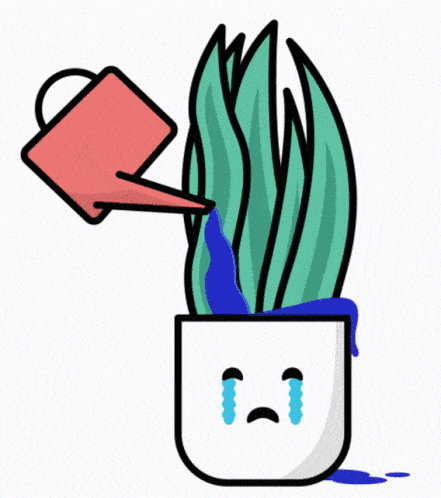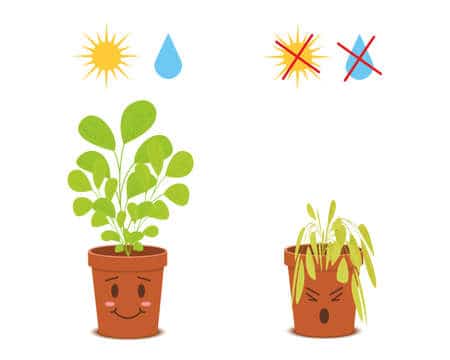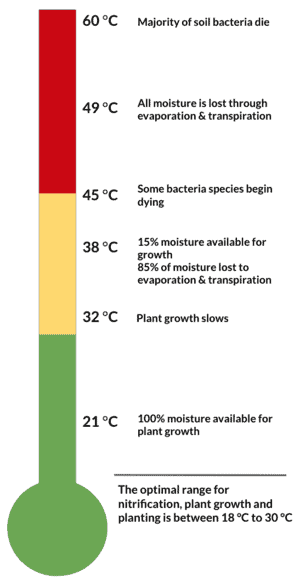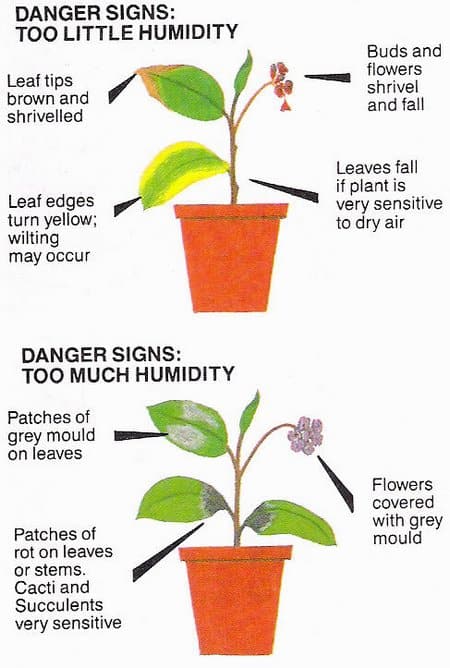Caladium is an evergreen perennial houseplant that boasts vibrant heart-shaped leaves in different colors and sizes with minimal care.
However, the tropical plant is quick to show problems, especially with drooping foliage, when they are left in an unhappy state.
In fact, drooping leaves are one of the earliest indications of something severe to come.
Read on to find out how to identify and diagnose drooping leaves to figure out the problem with your Caladium.
Table of Contents Show
Is it Normal for Caladium to Begin Drooping?
In winter, drooping leaves are typical with the Caladium plant (Caladium x hortulanum).
When the temperature drops below 65-degrees Fahrenheit in winter, the plant leaves will begin drooping due to cold stress.
However, it can be quite an uncommon phenomenon when it occurs at other times of the year.
If your Caladium has begun drooping in spring or summer, you should know something is off.
A slight change in regular care can push the foliage into stress, causing drooping leaves, often accompanied by leaf yellowing, discoloration, slowed growth, or stem wilting.

Being a tropical plant native to warm regions of central and South America, it is intolerant to temperature fluctuations and other factors that make it fussy.
Hence, if your Caladium is also drooping, be assured you are not the only one.
However, it would require immediate intervention to stop or prevent further damages caused by massive drooping.
Find out about 12 different varieties of Caladium houseplants.
Why is My Caladium Drooping?
Your Caladium will begin drooping for a variety of reasons.
However, it is vital to figure out what may be causing an untimely drooping of leaves so you can administer the solution before it worsens.
Here are the most probable reasons for drooping Caladium.
| Problem | Causes |
|---|---|
| Overwatering | Although it loves moist soil, waterlogged soil may prevent the tubers from obtaining and transferring nutrients. |
| Underwatering | It is a drought-intolerant plant, where missing out on frequent watering can render compact soil that chokes the tubers. |
| Direct Sunlight | Exposure to direct sunlight can burn the leaves, causing crispy and drooping leaves. |
| Temperature Stress | The temperature dropping below 65°F can send the plant into cold stress. |
| Improper Potting Mix/Soil | Poor soil condition lacks moisture, causing dry and drooping plants. |
| Over Fertilization | Over-fertilizing, especially with Nitrogen, causes salt buildup in the soil. |
| Low Humidity | Low humidity levels may dry the plant out, causing a loss in turgidity (full of liquid). |
| Insufficient Pot Size | Excess root bound condition leads to slowed growth with drooping foliage. |
| Light Stressed | The low light affects the photosynthesis process, causing drooping foliage. |
| Seasonal Die-back | Caladium will wilt or droop in fall and winter. |
How to Fix Drooping Caladium?
Here is how you can identify and treat problems with your Caladium in time to stop drooping.
You will also find some proven tips to prevent the onset of problems in the future.
1. Overwatering Issue
Soil moisture is critical to Caladium’s health, where they require frequent watering to ensure evenly moist soil.
However, excess watering could prove to be more fatal than beneficial.
The waterlogged soil clogs the air spaces in the soil, preventing air from reaching the tuber roots. Once the tubers start rotting, the overall body will lose its structure, causing droopy leaves.

Other indications include decayed lower stems, slowed growth, and yellowing of leaves.
Before applying a solution, slide out the plant to inspect for root rot and start separating the dying roots (black, dark, or mushy) from the healthy ones.
Solutions
- Use a pruning shear to cut the affected roots and apply fungicide on the fresh cuts to prevent fungus infestation.
- Prepare a fresh Caladium potting mix and transplant the plant in the new pot.
- However, do not immediately water the pot. Let it sit until the leaves start showing signs of progression.
Preventive Measures
- Provide 2-3 inches of water per week to a 5-inch container in the growing season (spring and summer).
- Water every 18 to 21 days in fall and winter or when the top few inches of soil dries out.
- Use a soil moisture meter to check the soil moisture level every week. Anything above eight on a 1-10 scale indicates excessively wet soil.
2. Under Watering Issue
Similar to overwatering issue, underwatering the Caladium may also cause drooping leaves.
Caladium is a drought-intolerant plant that fails to thrive in dry soil.
The dried or compact soil will choke the tubers and prevent them from getting oxygen and essential microorganisms to retain healthy leaves.

However, before the plant begins drooping, your Caladium will turn dormant, and leaves will turn crispy due to excess evaporation.
The drooping caused by underwatering would resemble the plant suffering from excess dehydration, especially in summer.
Look out for crispy leaves with yellowing or brown edges as the preliminary signs of a dried plant.
Solutions
- Place the plant pot on a pebble tray filled with water to let it naturally soak up the moisture from underneath.
- Fill a large container with water and immerse the pot inside it to quickly moisten the soil.
- Spraying water or misting the caladium leaves will initiate recreating the moisture level.
- Check whether the top few inches of soil still feel dry to decide on deep watering the plant.

Preventive Measures
- Water the plant every week with 2-3 inches of water once a week to keep the soil evenly moist.
- Mist the plant leaves in summer, especially when the temperature rises above 75, to prevent evaporation.
- Use a soil moisture meter every week. Anything under 4 indicates a severely dehydrated Caladium plant.
- Apply 2 to 3 inches of pine straw mulch around the plant to retain enough soil moisture.
3. Direct Sunlight
Direct sunlight may become a significant reason to worry because Caladium does not tolerate overexposure to direct sunlight.
The shade-loving plant does well in medium-light levels found in partial shade or diffused sunlight.
As per the rule, Caladium needs over 8 hours of bright indirect sunlight to grow and maintain its beautiful foliage.
However, exposing their leaves to direct sunlight or leaving them under the scorching sun for a significant time may cause leaf drooping.

The intense heat and light will increase the evaporation process, where the excess loss of water from leaves (excess transpiration) will cause droopiness.
Exposing Caladium to direct sunlight also causes leaf burns and bleaching.
You would know this by the edges of the drooping leaves turning brown or yellow, which gradually turn whitish.
Solutions
- Move your plant from its existing location to a shade when you notice these signs.
- Find a spot at least 5-feet away from a window or door that receives direct sunlight.
- Trim the badly affected leaves (crispy, bleached, or dead) to redirect the plant’s energy to healthy sections.
- Temporarily boost the humidity around the plant for a speedy recovery by installing an electric humidifier.
- Increase the watering frequency to hydrate the plant and mist the leaves.
- Keep your plant in a somewhat shady location. It aids in preventing direct sunlight contact, which causes excessive water evaporation.
- Providing a humid environment for your plant will aid in its hydration.
Note: Caladium will not photosynthesize or utilize sunlight to produce sugars (food) without adequate light, causing wilted or drooping foliage.
4. Temperature Stress
Caladium is a warmth-loving plant that hates sitting in cool temperatures or rapid shifts in climate.
It is prone to suffer from cold drafts when left outdoors or in open areas such as drafty windows or doors when the temperature starts plummeting under 65°F.
In fact, anything under 50°F can slow down its growth and even kill the plant.

The caladium exposed to prolonged cool temperatures will begin showing signs of distress, including drooping foliage.
Another indication of the cold-stressed Caladium is stunted growth and yellowing foliage.
On the other hand, a soaring temperature may also cause a sick plant.
Anything over 85°F can suck the humidity from the air and leave your plant high and dry, causing evaporation from the leaves.
Solutions
- Move your plant inside and place them on a heating mat.
- Cover the plant with insulation, a frost blanket, or a plastic bag to protect it from cold drafts.
- Cover the soil with a fine layer of pine mulch to retain warmth in the ground.
- Cut back on watering and fertilization until the drooping leaves get their original shape.
- As a preventive measure, provide an ideal temperature range of 70°F to 85°F (21°C to 30°C) around the year.
Pro Tip: Do not place your cold-stressed plant in front of the air conditioner or heater as they despite the sudden burst of hot air.
5. Improper Potting Mix
Caladium thrives in well-drained, perlite-mixed potting soil that retains enough moisture and essential microbial organisms.
However, poor irrigation practices, sterile soil, or the wrong potting mix can run the soil out of moisture.
A soil that fails to retain moisture will quickly turn compact and prevent plant roots from getting water, oxygen, and nutrients, leading to a dry plant.

A dehydrated Caladium will begin drooping and primarily exhibit signs of stunted growth.
Start with inspecting the soil condition: light, dry, and compact texture indicates the poor potting mix.
Solutions
- Consider repotting your plant in a fresh potting mix if you have not repotted it in a few years.
- Choose a potting mix rich in perlite to keep the soil aerated.
- Revive and nourish the existing soil by adding organic compost and manure in layers.
- Cover the soil with a fine layer of pine straw mulch to hold the moisture in.
- Ensure your potting mix is slightly acidic (5.5-6 pH level) by checking the soil pH meter and amending accordingly.
6. Overfertilization
Caladium, like any other houseplant, enjoys regular, well-balanced plant food throughout the growing season.
However, overfeeding them with nutrients may build up the accumulation of fertilizer salts around the roots.
As the concentration of salt build-up exceeds, the plant roots will fail to take up water, leading to stunted growth with decayed stems and drooping leaves.

Especially, a fertilizer with excess nitrogen can lead to quick salt buildups in the soil.
Another indication of the overfed plant is a visible layer of salt seen as a yellow or white crust on the top of the soil.
Solutions
- Deepwater the pot to wash off the build-up of salts. Pour it into the continuous stream so the salt can drain out of the bottom holes.
- Remove the damaged foliage. The severely crusted plant will need repotting to a fresh potting mix, but hold back on fertilizing until the plant seems to revive.
- Leach potted plants with fresh water every four to six months to prevent salt buildup.
- Apply slow-release fertilizer or all-purpose liquid fertilizer diluted to half-strength as a preventive measure.
7. Low humidity
Caladium grows at a relatively moderate humidity level in the wild; hence, they need the same humid environment at home.
The low humidity level, especially in summer, may suck the plant dry, causing them to lose their turgidity and stored moisture.

It is primarily indicated by brown and crispy foliage with a droopy appearance.
Caladium thrives in humid conditions with at least 50% relative humidity as a tropical plant.
Hence, you would need to replicate the same condition at home to witness a healthy plant.
Solutions
- Huddle the plants together or add an electric humidifier to the room.
- Mist the plant leaves, especially in the morning, to boost the humidity in the surrounding air
- As a long-term solution, add the pot to a pebble tray filled with fresh water.
- Do not place your plant in direct contact with heaters or cooling vents.
8. Insufficient Pot Size
Caladiums grown in a small pot tend to lose their solid and upright leaves once they become root-bound.
The leaves and stems begin to droop when the growing medium becomes too crowded.
It is an indication to repot the plant in a larger pot with a fresh potting mix.

Likewise, some Caladium plants may begin drooping immediately after repotting.
The mishandling or excess pruning of the root system may push back the plant, disrupting nutrition and water supply.
Solutions
- Repot your Caladium every two years to a new pot at least 2-inches bigger than the previous one.
- Ensure the pot has multiple drainage holes at the bottom to let out excess water.
- When pruning the Caladium root, ensure to cut only dead, decayed, or brownish feeder roots but the main root bulb at the center.
- Do not let the plant with bare roots sit outside. Instead, immediately transplant it after taking it out from a pot.
- Cut back on watering and fertilizing until the plant seems to revive.
9. Seasonal Die-back
Caladium is a perennial plant that will actively grow throughout spring and summer before dying for a certain period of inactivity.
Marked as dormancy, the plant growth briefly slows down, and leaves begin to wilt or droop in fall and winter.
Sadly, every Caladium will go through this phase; hence, you cannot do anything.
Solutions and Preventive Measures
- Cut back on watering, fertilizing, and pruning when the plant goes into dormancy.
- Let them relax in a warm location with low to moderate lighting.
- Begin regular care in early spring by pruning the dead or decayed foliage and continuing a weekly watering schedule.
- Please bring them back to partial sunlight, close to windows or doors, once the spring approaches and the risks of cold drafts die out.
Frequently Asked Questions About Drooping Caladium
Will Drooping Caladium Live Longer?
Caladiums are perennial plants that will survive for many seasons, despite drooping foliage.
However, you must treat the drooping on time and keep it problem-free. Rest assured, and your plant will survive for years to come.
How to Prevent Dying Leaves in Winter?
There is no way to prevent the Candidum leaves from dying back in winter
It is their way of telling that they are resting (dormant).
Do not worry, and continue the regular care from early spring to bring it back to its fullest form.
Does a Droopy Caladium have any Benefits?
Caladium is a beneficial houseplant that helps improve air quality by reducing air-borne toxins.
However, limp foliage is no good as they are ineffective in trapping dust, air-borne toxins, and pollutants.

Conclusion
Some plants are simple and easy to care for, and Caladiums are no different. However, wrong growing conditions never complement any houseplant.
You should know about the care and needs of the Caladium plant to determine the causes of drooping foliage and resort to the proper methods to solve the problem.
Use this guide and follow the above-given simple steps to watch, diagnose, and treat your drooping Caladium.
